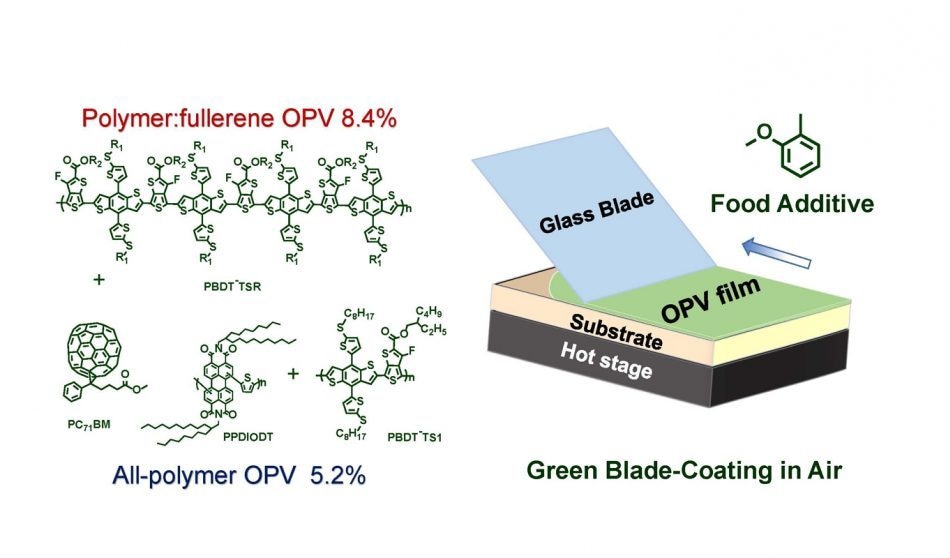Sep 30 2016
 Schematic illustration and chemical structure of semi-printed plastic solar cells in air, using food additive o-MA as solvent. (Credit: Long Ye, NC State)
Schematic illustration and chemical structure of semi-printed plastic solar cells in air, using food additive o-MA as solvent. (Credit: Long Ye, NC State)
Scientists at North Carolina State University and the Chinese Academy of Sciences have developed an effective, semi-printed plastic solar cell without using halogen solvents that are hazardous to the environment. These cells can be developed at room temperature, which creates implications for commercial production on a large-scale.
Organic photovoltaics, or plastic solar cells, can be used for many applications as they are light, transparent, flexible, and inexpensive to produce. However, the solvents that contain halogen used in the production of these plastic solar cells make their large-scale commercialization impossible.
These solvents are essential to ensure that the structure or morphology of the cell optimizes its energy efficiency, but they are hazardous to the environment. A controlled environment is essential for the use of such harsh chemicals, adding to the production cost.
Long Ye, the lead author of the paper detailing the research and NC State’s postdoctoral research scholar in physics, wanted to discover if equally efficient morphology can be obtained in the manufacturing process using nontoxic solvents. Ye’s team used o-methylanisole (o-MA) as a solvent to develop proof of concept semi-printed plastic solar cell. The o-MA solvent is nontoxic in nature and is often used as a flavoring agent in foods.
Soft X-ray methods were used by the scientists to analyze their solar cell’s morphology. The results showed that the device performance, morphology and crystalline features of the o-MA based solar cell were similar to the cells manufactured using halogenated solvents.
The solar cell had an overall efficiency rating of approximately 8.4%. Additionally, the cell can be manufactured at ambient or room temperature using blade coating. The process of blade coating involves spreading a thin layer of photovoltaic film on a flexible or rigid substrate by employing a glass blade. This process is compatible in large-scale commercial production.
Two of the key requirements for mass producing these solar cells are that the cells can be produced in the open air environment and that the process doesn’t pose health or environmental hazards. Hopefully this work can help pave the way for printing solar cells in ambient air.
Long Ye, Postdoctoral Research Scholar, North Carolina State University
The paper detailing the work is published in Chemistry of Materials. Harald Ade, a NC physicist at NC State is the corresponding author, while Professor Jianhui Hou, from the Chinese Academy of Sciences is the co-corresponding author of the paper. Yuan Xiong from the Ade group collaborated with Brendon T. O’Connor and Abay Gadisa to fabricate the solar cell. The UNC-GA Research Opportunity Initiative grant and Office of Naval Research grant N0014-15-1-2322 financially supported the endeavor.